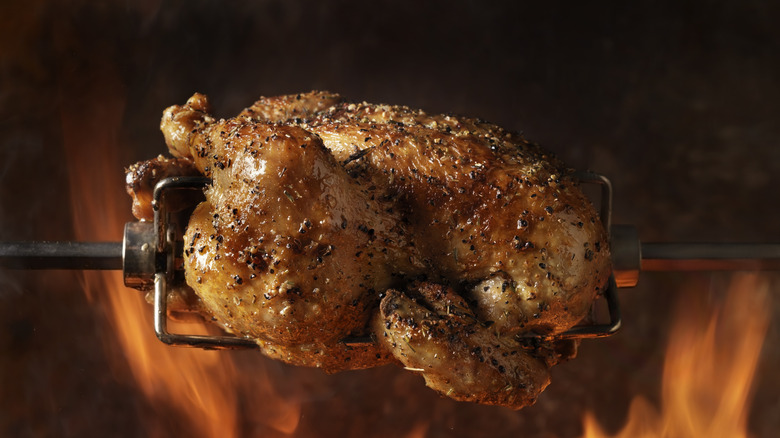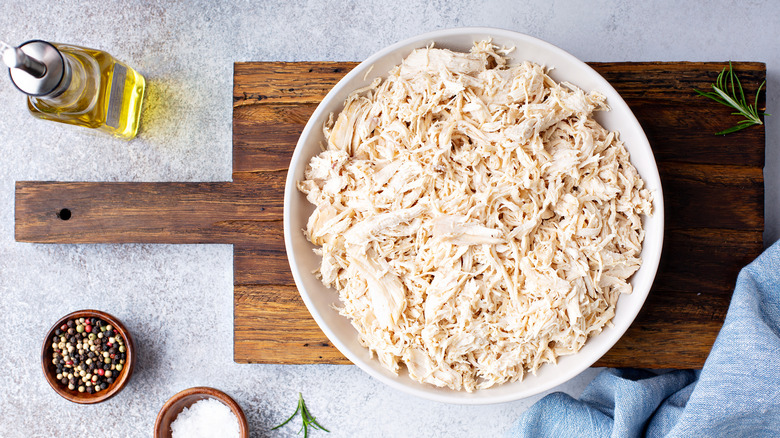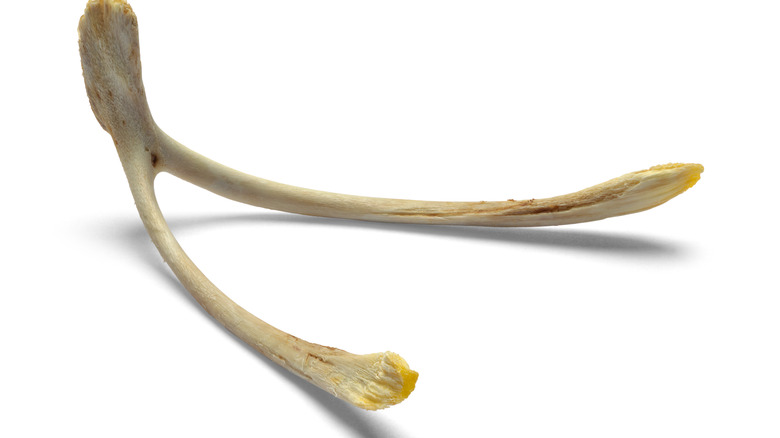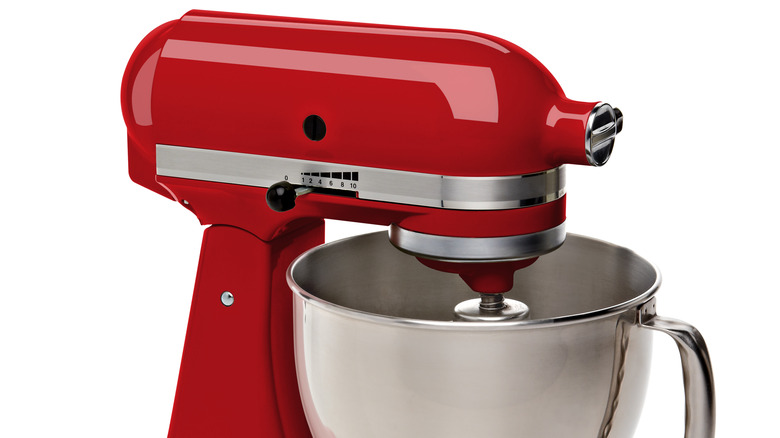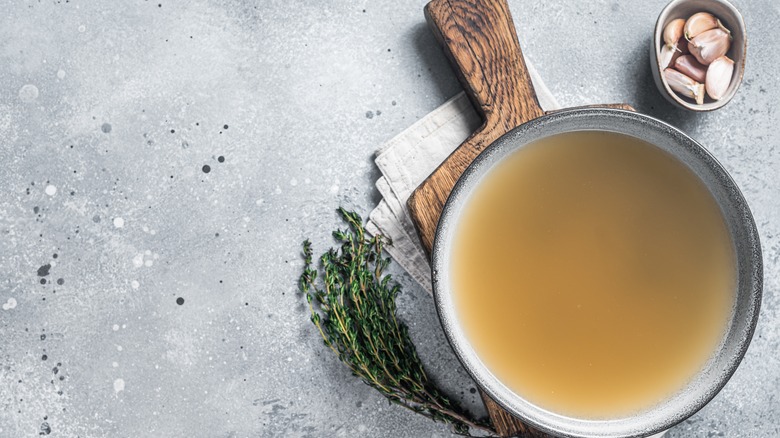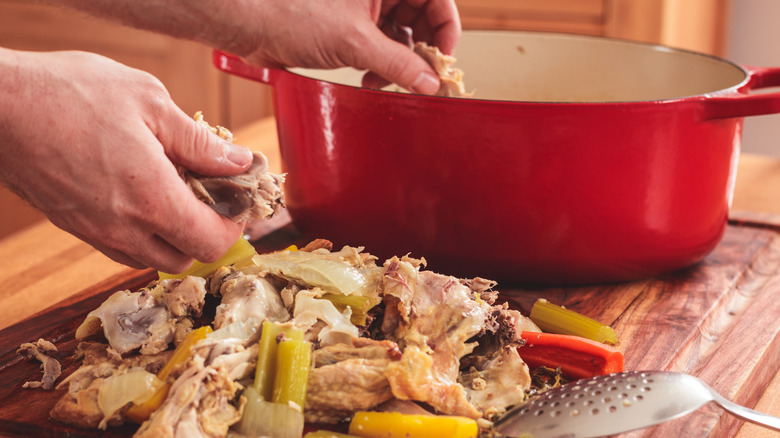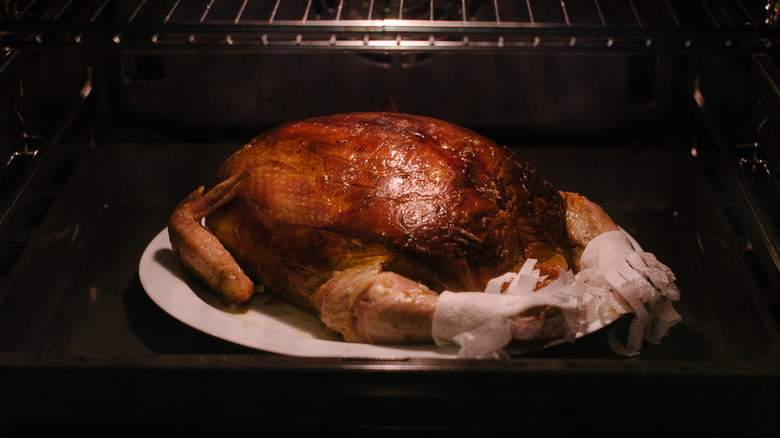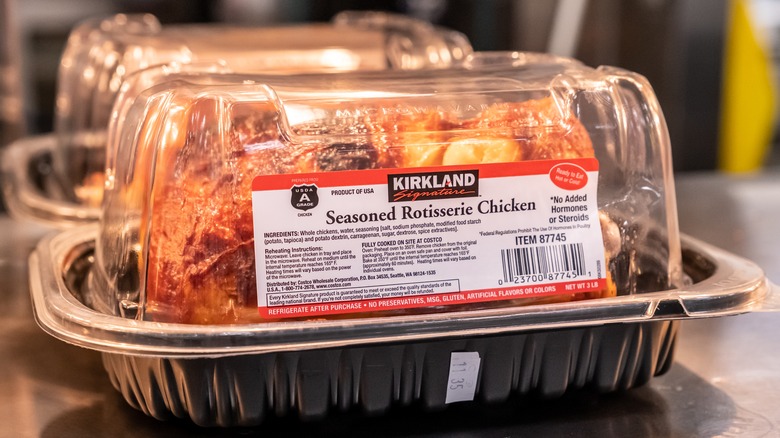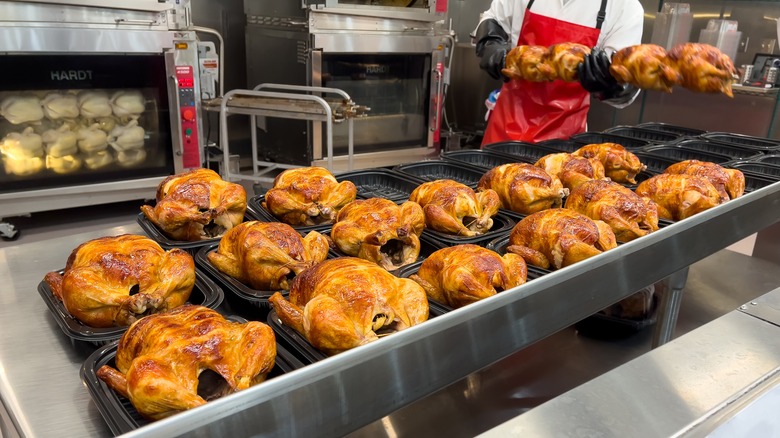8 Rotisserie Chicken Hacks You'll Wish You Knew About Sooner
Store-bought rotisserie chickens have become a staple for home cooks, the perfect thing to grab on your way out of the supermarket to get dinner on the table in minutes. But, rotisserie chickens don't just make a phenomenal meal on their own. Leftovers can be enjoyed hot or cold, either on their own or transformed into chicken salad, pasta sauce, quiche, and more.
Given their popularity, it's no surprise that folks have come up with loads of hacks to make the most of store-bought rotisserie chickens. There are easier ways to carve and shred them and tips for reheating them so that they re-emerge as tender, juicy, and crispy as they were when you first purchased them. On the price front, there are ways to get the best bang for your buck in the deli aisle and to get even more discounts on this famed Costco loss leader. Here are all of the tips and tricks you need to know if you want to be a true rotisserie chicken master.
1. It's easiest to carve or shred rotisserie chicken while it's still hot
If you're planning on using leftover rotisserie chicken in quick-and-easy chicken soup or chicken quesadillas, you'll want to strike while the iron is hot — literally. In an Instagram reel, Costco worker Melissa offered one of the most essential rotisserie chicken hacks: the importance of working with a hot bird. "I do it while it's hot or it will not work," she says.
Hot chicken doesn't just shred more easily because the muscle fibers are looser when they're warm. It's also linked to the cooking juices, which are more fluid when warm and before they have time to congeal and become gelatinous. Of course, you don't want the chicken to be so hot that it'll burn your hands! Give the chicken at least 10 minutes to cool before beginning to shred, and if at any point it becomes uncomfortable to touch, wait an additional five minutes before picking up the task once more.
2. Removing the wishbone makes your work way easier
Zeroing in on the wishbone from a rotisserie chicken doesn't just give you the opportunity to make a wish. Removing this y-shaped bone at the breast of the chicken also makes it way easier to carve. Cutting out the wishbone makes it far easier to get beneath the breast meat, which means you can remove it in just one piece.
Find the bone at the neck of the chicken and make a small cut behind it. Simply yank it out (make a wish!) and from there, you can run your fingers along the backbone and under the breast. The entire slab of delicious white meat should come off the bone in just one piece. It bears mentioning that not everyone agrees with these hacks. Some experts say that carving the legs off the carcass is an easier place to start. Give both approaches a try and see which one you prefer!
3. You can use a stand mixer to shred the chicken faster
While it's certainly possible to shred your chicken entirely by hand or with two forks (the latter coming in handy if your fingertips are sensitive to heat), one hack that will speed things up considerably is to take advantage of the stand mixer and have it do the job for you. Simply place the warm chicken into the bowl of the stand mixer, and use the flat beater attachment to work the chicken on low speed. All you need is between 30 and 60 seconds to transform the warm chicken into perfect shreds.
Of course, a stand mixer is an expensive bit of kitchen equipment. It's totally understandable that some would flinch at the idea of trying out this hack, only to find it does irreparable damage to this beloved kitchen tool. But, don't worry — you can breathe easy. Even Kitchen-Aid agrees that this hack passes muster!
4. You can save the juice to reinforce your own stock, soup, or gravy
When your rotisserie chicken begins to cool, you'll see a whole host of juices pooling and congealing in the bottom of the container. Whatever you do, don't throw this sludge away! As unappetizing as it may look, this gelatinous goo is liquid gold.
The solidified gelatin and cooking juices found at the bottom of your rotisserie chicken container can be salvaged and used much like stock when cooking soup, rice, pasta, potatoes, or even roasted vegetables, adding flavor and body to whatever you're making. You can also add it to store-bought broth or stock to lend a bit more depth. It can even be used to make a particularly flavorful homemade gravy. Heat it with about a tablespoon of butter in a pan, then add a tablespoon or two of flour and whisk to make a roux. Add chicken broth or stock and bring to a simmer, and presto: homemade gravy in minutes.
If you're not going to use it right away, freeze that goo in an ice cube tray until solid, then store it in a plastic bag in the freezer until ready to use.
5. You can even use the bones
Once you've removed the chicken from the carcass, please, please don't toss the remnants out! Those bones are still full of flavor and are ready to be simmered in water laced with aromatics to create an easy, delicious chicken stock.
To do this at home, just nestle the leftover carcass (and any residual drippings, including anything that looks snotty or congealed) with aromatics like carrots, celery, onion, parsley, bay, garlic, and peppercorns. Use fresh veggies, or, if you've had the forethought, grab that bag of onion skins, carrot tops, and more you've got in the freezer. Next, cover the carcass and aromatics with cold, fresh water, and simmer, partially covered, for two hours. In a crock pot, a similar blend can cook for two to three hours on high or four to six hours on low to render the perfect, golden broth. This food waste reduction hack means that fresh, homemade stock is never too far away.
6. You can get crispy skin even when you reheat rotisserie chicken
Crispy skin is totally the best part of a rotisserie chicken. But, once the chicken has cooled, it can seem impossible to get it to crisp up again. Luckily, there's a hack for that. To reheat roast chicken to crispy perfection without drying it out, place it in an oven-safe dish with a cupful of chicken broth and then cover it with foil. Reheat for 25 minutes at 350 F before removing the foil to allow the skin to crisp up.
If that's not giving you the crispiness you crave, you could also gild the lily by brushing the chicken with a bit of butter before it goes into a much hotter oven — somewhere between 450 and 475 F. To keep it from drying out, be sure to cut the chicken into individual portions before placing it in the oven for just five to 10 minutes to warm through.
If you've got an air fryer, you're in luck. All it takes is three to four minutes at 350 F for your rotisserie chicken to return to all its crispy glory.
7. You can find a fresher one if you judge by weight
Costco's rotisserie chickens are a market leader for sure, and coming in at about three pounds of cooked chicken (as compared to just two pounds on average at other stores), they're also behemoths of the genre. According to Rick Martinez, former editor for Bon Appétit, picking an even heavier one isn't just a good way to get a bang for your buck. The heaviest chicken, he says, is also likely the freshest, juiciest one.
It makes sense when you think about it. After all, the longer those chickens sit under a heat lamp, the more of their moisture evaporates, making them both lighter and dryer. Feeling for heft means you've found a chicken whose juices have yet to be sacrificed to the persistent heat of the lamp. "You'll feel a noticeable difference between the birds that just came out of the oven and ones that have been sitting there all day," Martinez says. So, don't fear the haters — pick up each chicken until you've found your prize.
8. You might get a discount if you buy it right before the store closes
At just $4.99 per chicken, Costco's rotisserie chickens are one of the store's best deals — and a known loss leader. It's no wonder the store sold more than 64 million of them in 2018 alone.
But, whether you get your chicken from Costco or another grocery store, you can get an even better deal if you swing by the rotisserie chicken counter towards the end of the day. Might they be sold out? Of course. If you're lucky, a few rotisserie chickens will remain, and since it's hard to sell day-old chicken, it's likely the store will have discounted any remaining birds to ensure that they don't go to waste. Plus, if you don't mind snagging a cold chicken (or, for that matter, day-old chicken), Costco will occasionally throw in an extra half-chicken for just a dollar more.
